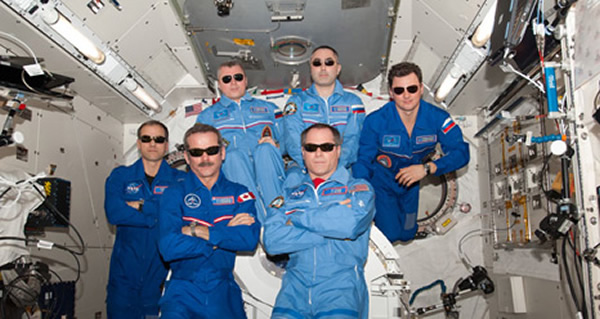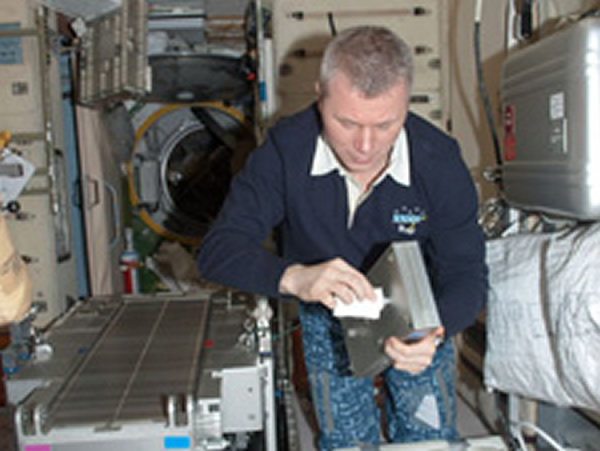Spacesuit Maintenance and Science Inside Station, Robotics Outside
The Expedition 34 crew members pose for an in-flight crew portrait in the Kibo laboratory of the International Space Station.
Flight Engineer Oleg Novitskiy performs routine in-flight maintenance on the Treadmill Vibration Isolation System in the Zvezda service module.
The Expedition 34 crew members living and working aboard the International Space Station tested a spacesuit maintenance procedure and worked with a variety of science experiments Monday, while ground-commanded robotics took center stage on the exterior of the orbiting complex.
Flight Engineer Tom Marshburn worked with a spacesuit cooling loop maintenance procedure that is part of an International Space Station Testbed for Analog Research (ISTAR) activity that mimics robotic and remotely controlled activities that may one day be used on a voyage to Mars. The station offers a unique platform to test future exploration systems and operations because it provides a long-duration, zero-gravity space environment and the opportunity to evaluate many factors not available in other analog missions.
Marshburn also performed some maintenance in the Kibo laboratory, removing and replacing bolts in the Protein Crystallization Research Facility.
Commander Kevin Ford began several days of work with the Capillary Flow Experiment-3, which investigates how fluids flow across surfaces in a weightless environment. Results from this experiment will improve computer models used to design fluid transfer systems and fuel tanks on future spacecraft.
Flight Engineer Chris Hadfield worked with the InSPACE-3 experiment, which examines the physical property changes in fluids containing ellipsoid-shaped particles when a magnetic field is applied. These colloidal fluids are classified as smart materials, transitioning to a solid-like state in the presence of a magnetic field, and this technology may lead to the design of bridges and buildings that can better withstand earthquakes.
Flight Engineers Evgeny Tarelkin, Oleg Novitskiy and Roman Romanenko performed various inspections and maintenance duties in the Russian segment of the station, tagging-up with flight control teams in Russia as needed.
Tarelkin and Novitskiy worked with the Bar experiment, which looks at methods and instruments for detecting the location of an air leak from one of the station’s modules.
Tarelkin and Romanenko checked out the Coulomb Crystal experiment, which gathers data about charged particles in a weightless environment.
Meanwhile on the exterior of the orbiting complex, flight controllers commanded Canadarm2, the station’s 57.7-foot robotic arm, and Dextre, the Canadian Space Agency’s twin-armed robotic “handyman,” to transfer a failed Main Bus Switching Unit (MBSU) from its temporary stowage location on External Stowage Platform 2 outside the Quest airlock to External Logistics Carrier 2 on the station’s starboard truss. The failed MBSU was replaced last summer during spacewalks by Expedition 33 Commander Suni Williams and Flight Engineer Aki Hoshide.













